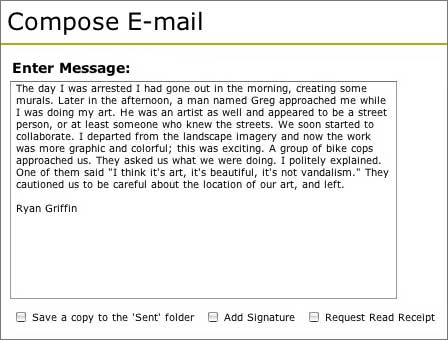Artists Will Be Prosecuted
by Divya Menon
Ryan Griffin, a 22 year old artist and recent graduate from SAIC, was arrested and charged with a misdemeanor on May 2nd. While chalking murals on the Dearborn bridge, the young artist was cuffed and taken to the District 1 police station where he was charged with 'criminal damage to property' and forced to spend the night in jail.
According to an ordinance issued by the City Council of the city of Chicago, "graffiti means an inscription, drawing, mark or design that is painted, sprayed or drawn directly upon the exterior of any building or other structure and is visible from the public way." (Section 7-28-065 of the Municipal Code of Chicago) Since 1993 the Daley administration has made concerted efforts to spruce up the city with its Graffiti Blasters program. Through the program, four million tax dollars are channeled every year into the removal of graffiti – alleged traces of vandalism and gang activity – from both publicly and privately owned property. Give Graffiti the Brush is another program chartered by the city of Chicago to fight this social encumbrance. Giving graffiti the brush of death ultimately serves the interests of private property holders who now do not have to pay for repair; hence Daley's efforts to appease the victims (i.e. small businesses and large corporations) of these misdemeanors.
Law enforcement officials have been reticent to divulging information on the circumstances leading up to the arrest. Officer Guillermo Gonzalez, who executed the arrest, claims that an anonymous citizen called 911 regarding Griffin's activities and prompted the department to take action. In a brief telephone interview, Gonzalez expressed his desire to simply book Griffin and let him go but went on to admit that his "supervisor told (him) that they had to be arrested." The official in question is Lieutenant Liace, who has not responded to efforts made to contact him.

Clashes between artists working in the public realm and the juridical systems that regulate social activity often lead to debates on the nature of the art world/real world divide. When and where is it considered acceptable to create art? Is it the form or the content of the work that determines its legitimacy? In the case of Diego Rivera, the famous Mexican muralist, it was definitely the latter (read the content). Circa 1933, Rivera's Rockefeller-commissioned mural was smashed to powder after he painted Lenin's face into the mural.
But the mural form is, in and of itself understood as constituting a higher art than lowly graffiti. Griffin's site-specific works are visually arresting; placed in the dreary loop-scape that surrounds the School, the desert landscapes and lighthearted graphics are not intended to offend or mark gang presence -- the two main charges leveled against graffiti. Is this a public nuisance or a valid art form? Can graffiti be understood in the same terms as murals (sans the commissioning authorities)? Does the brush that eradicates gang symbols ever stop the violence? Does, in the words of Michel de Certeau, "everyday life (invent) itself by poaching, in countless ways, on the property of others?"
"As an artist who works in the public sphere, have you ever had any harrowing experiences with the law?" I asked Sarah Alford, an SAIC graduate student.
"I started doing work outside of a studio in Halifax, Nova Scotia, where I had no trouble from the police ever, even though I was, initially, a little bit worried and self-conscious about that. But I stopped worrying because the police seemed to have more important things to do than worry about me. I do have to work my way up to feeling brave enough to do the work outside. Now it seems, I'll have to feel even braver. This is a frightening story for an artist, and it is meant to frighten us, and that's a frightening thing." |
Through his work, Griffin says he attempts to deal with the "problem of creating (unsanctioned) art in the street." Using chalk to create ephemeral works on the city's built environment, he strives to "push the boundaries (between) what is accepted and what is considered illegal." The impermanence of Griffin's medium makes it especially hard to tag the work (fully intended, that pun) as amounting to 'vandalism.' In the words of another young street artist (who wishes to remain anonymous), the cops probably "only arrested him so they didn't look like idiots for arriving 5 cars deep on a college kid with chalk in his hand; (they) had to make it look like something serious was going on." Street art is tricky business. The fact that Griffin was creating brightly colored murals in a heavily surveilled spot during rush hour does not help either. One cannot even use a professional-grade camera (or a tripod) in Millenium Park, because the park itself is considered "intellectual property."
What Griffin's story tells us is that there is a threat to the concept of "public space" and what is left of it is meticulously controlled. The fact that neither the form nor the content of Griffin's work was in any way offensive notwithstanding, the smoke (in this case the phone call) was enough to justify the arrest. The fact that the artist was forced to spend a night in jail reflects an awkward, and possibly unproportional municipal response to artistic expression. After all, as an anonymous artist working in the city, "there are better ways to be a super hero than by arresting a sidewalk chalk artist."
|